Twenty fifth dynasty of egypt Stock Photos and Images
(37)See twenty fifth dynasty of egypt stock video clipsQuick filters:
Twenty fifth dynasty of egypt Stock Photos and Images
 Stela of princess Paabtameri. 25th Egyptian dynasty The princess is depicted in supplication to teh God ra-Harakte on an Egyptian stela. Princess Paabtameri was a member of the Nubian royal family of the 25th Egyptian dynasty. The Twenty-Fifth Dynasty of Egypt, also known as the Nubian dynasty or Kushite Empire, was a line of rulers originating in the Kingdom of Kush. They reigned in part or all of Ancient Egypt from 760 BC to 656 BC. Stock Photohttps://www.alamy.com/image-license-details/?v=1https://www.alamy.com/stock-photo-stela-of-princess-paabtameri-25th-egyptian-dynasty-the-princess-is-57345320.html
Stela of princess Paabtameri. 25th Egyptian dynasty The princess is depicted in supplication to teh God ra-Harakte on an Egyptian stela. Princess Paabtameri was a member of the Nubian royal family of the 25th Egyptian dynasty. The Twenty-Fifth Dynasty of Egypt, also known as the Nubian dynasty or Kushite Empire, was a line of rulers originating in the Kingdom of Kush. They reigned in part or all of Ancient Egypt from 760 BC to 656 BC. Stock Photohttps://www.alamy.com/image-license-details/?v=1https://www.alamy.com/stock-photo-stela-of-princess-paabtameri-25th-egyptian-dynasty-the-princess-is-57345320.htmlRMD988F4–Stela of princess Paabtameri. 25th Egyptian dynasty The princess is depicted in supplication to teh God ra-Harakte on an Egyptian stela. Princess Paabtameri was a member of the Nubian royal family of the 25th Egyptian dynasty. The Twenty-Fifth Dynasty of Egypt, also known as the Nubian dynasty or Kushite Empire, was a line of rulers originating in the Kingdom of Kush. They reigned in part or all of Ancient Egypt from 760 BC to 656 BC.
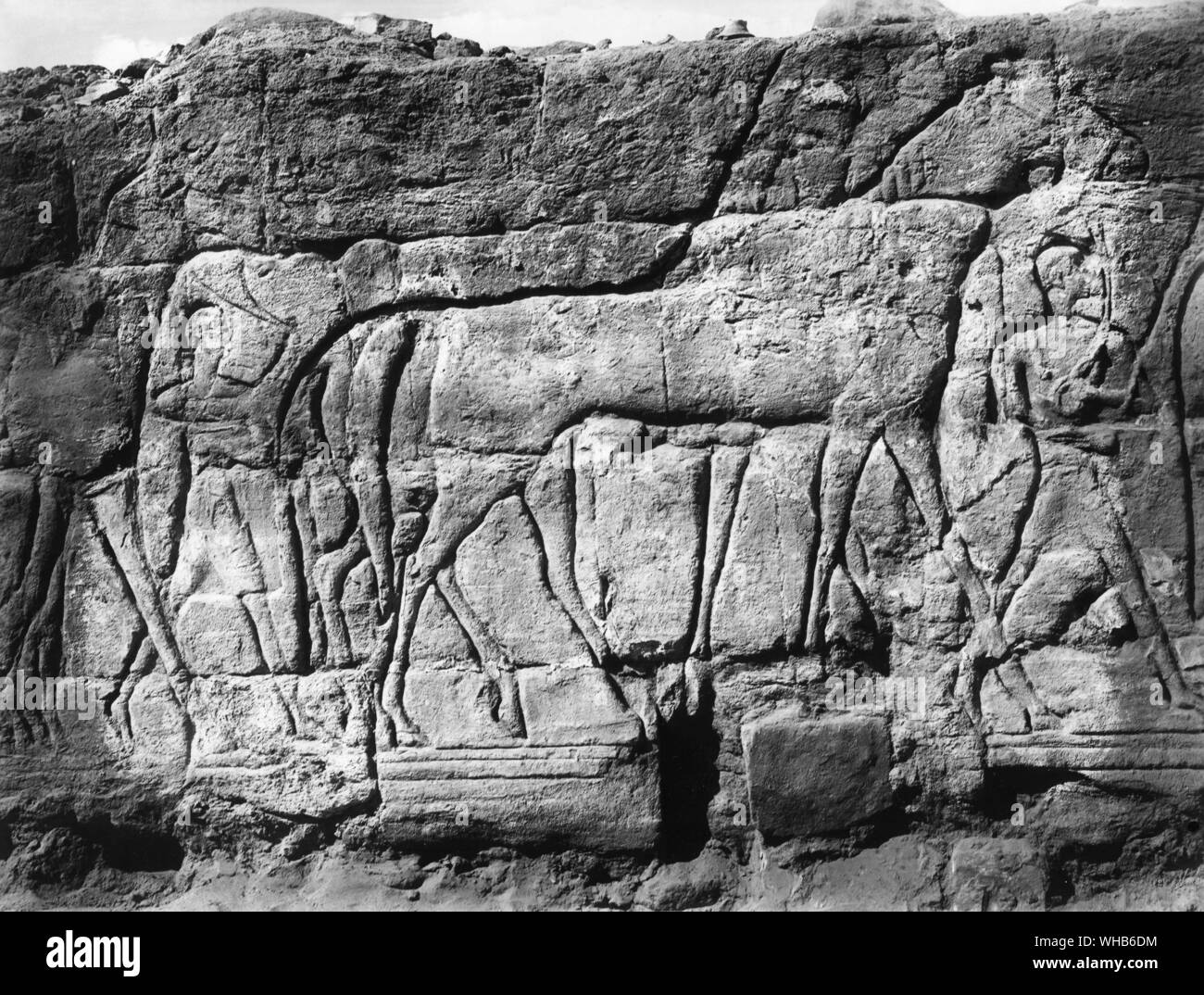 Men leading horses King Piankhy Ethiopian King XXV Dynasty Gebel Barkal Temple (Sudan) Upper Egypt late period - Piye, whose name was once transliterated as Py(ankh)i. (d. 721 BC) was a Kushite king and founder of the Twenty-fifth dynasty of Egypt who ruled Egypt from the city of Napata, located deep in Nubia, Sudan. . Stock Photohttps://www.alamy.com/image-license-details/?v=1https://www.alamy.com/men-leading-horses-king-piankhy-ethiopian-king-xxv-dynasty-gebel-barkal-temple-sudan-upper-egypt-late-period-piye-whose-name-was-once-transliterated-as-pyankhi-d-721-bc-was-a-kushite-king-and-founder-of-the-twenty-fifth-dynasty-of-egypt-who-ruled-egypt-from-the-city-of-napata-located-deep-in-nubia-sudan-image268851232.html
Men leading horses King Piankhy Ethiopian King XXV Dynasty Gebel Barkal Temple (Sudan) Upper Egypt late period - Piye, whose name was once transliterated as Py(ankh)i. (d. 721 BC) was a Kushite king and founder of the Twenty-fifth dynasty of Egypt who ruled Egypt from the city of Napata, located deep in Nubia, Sudan. . Stock Photohttps://www.alamy.com/image-license-details/?v=1https://www.alamy.com/men-leading-horses-king-piankhy-ethiopian-king-xxv-dynasty-gebel-barkal-temple-sudan-upper-egypt-late-period-piye-whose-name-was-once-transliterated-as-pyankhi-d-721-bc-was-a-kushite-king-and-founder-of-the-twenty-fifth-dynasty-of-egypt-who-ruled-egypt-from-the-city-of-napata-located-deep-in-nubia-sudan-image268851232.htmlRMWHB6DM–Men leading horses King Piankhy Ethiopian King XXV Dynasty Gebel Barkal Temple (Sudan) Upper Egypt late period - Piye, whose name was once transliterated as Py(ankh)i. (d. 721 BC) was a Kushite king and founder of the Twenty-fifth dynasty of Egypt who ruled Egypt from the city of Napata, located deep in Nubia, Sudan. .
 Sudan: A Meroitic perfume container from al-Kadada, near Shendi. The Kingdom of Kush or Cush was an ancient Nubian state centred on the confluences of the Blue Nile, White Nile and River Atbara in what is now the Republic of Sudan. Established after the Bronze Age collapse and the disintegration of the New Kingdom of Egypt, it was centered at Napata in its early phase. After King Kashta ('the Kushite') invaded Egypt in the 8th century BCE, the Kushite kings ruled as Pharaohs of the Twenty-fifth dynasty of Egypt for a century, until they were expelled by Psamtik I in 656 BCE. Stock Photohttps://www.alamy.com/image-license-details/?v=1https://www.alamy.com/sudan-a-meroitic-perfume-container-from-al-kadada-near-shendi-the-kingdom-of-kush-or-cush-was-an-ancient-nubian-state-centred-on-the-confluences-of-the-blue-nile-white-nile-and-river-atbara-in-what-is-now-the-republic-of-sudan-established-after-the-bronze-age-collapse-and-the-disintegration-of-the-new-kingdom-of-egypt-it-was-centered-at-napata-in-its-early-phase-after-king-kashta-the-kushite-invaded-egypt-in-the-8th-century-bce-the-kushite-kings-ruled-as-pharaohs-of-the-twenty-fifth-dynasty-of-egypt-for-a-century-until-they-were-expelled-by-psamtik-i-in-656-bce-image344238100.html
Sudan: A Meroitic perfume container from al-Kadada, near Shendi. The Kingdom of Kush or Cush was an ancient Nubian state centred on the confluences of the Blue Nile, White Nile and River Atbara in what is now the Republic of Sudan. Established after the Bronze Age collapse and the disintegration of the New Kingdom of Egypt, it was centered at Napata in its early phase. After King Kashta ('the Kushite') invaded Egypt in the 8th century BCE, the Kushite kings ruled as Pharaohs of the Twenty-fifth dynasty of Egypt for a century, until they were expelled by Psamtik I in 656 BCE. Stock Photohttps://www.alamy.com/image-license-details/?v=1https://www.alamy.com/sudan-a-meroitic-perfume-container-from-al-kadada-near-shendi-the-kingdom-of-kush-or-cush-was-an-ancient-nubian-state-centred-on-the-confluences-of-the-blue-nile-white-nile-and-river-atbara-in-what-is-now-the-republic-of-sudan-established-after-the-bronze-age-collapse-and-the-disintegration-of-the-new-kingdom-of-egypt-it-was-centered-at-napata-in-its-early-phase-after-king-kashta-the-kushite-invaded-egypt-in-the-8th-century-bce-the-kushite-kings-ruled-as-pharaohs-of-the-twenty-fifth-dynasty-of-egypt-for-a-century-until-they-were-expelled-by-psamtik-i-in-656-bce-image344238100.htmlRM2B01B5T–Sudan: A Meroitic perfume container from al-Kadada, near Shendi. The Kingdom of Kush or Cush was an ancient Nubian state centred on the confluences of the Blue Nile, White Nile and River Atbara in what is now the Republic of Sudan. Established after the Bronze Age collapse and the disintegration of the New Kingdom of Egypt, it was centered at Napata in its early phase. After King Kashta ('the Kushite') invaded Egypt in the 8th century BCE, the Kushite kings ruled as Pharaohs of the Twenty-fifth dynasty of Egypt for a century, until they were expelled by Psamtik I in 656 BCE.
 Statues of pharaohs of the Nubian twenty-fifth Dynasty of Egypt discovered near Kerma displayed in the Kerma Museum; Kerma, Northern State, Sudan Stock Photohttps://www.alamy.com/image-license-details/?v=1https://www.alamy.com/statues-of-pharaohs-of-the-nubian-twenty-fifth-dynasty-of-egypt-discovered-near-kerma-displayed-in-the-kerma-museum-kerma-northern-state-sudan-image332592282.html
Statues of pharaohs of the Nubian twenty-fifth Dynasty of Egypt discovered near Kerma displayed in the Kerma Museum; Kerma, Northern State, Sudan Stock Photohttps://www.alamy.com/image-license-details/?v=1https://www.alamy.com/statues-of-pharaohs-of-the-nubian-twenty-fifth-dynasty-of-egypt-discovered-near-kerma-displayed-in-the-kerma-museum-kerma-northern-state-sudan-image332592282.htmlRM2A92TRP–Statues of pharaohs of the Nubian twenty-fifth Dynasty of Egypt discovered near Kerma displayed in the Kerma Museum; Kerma, Northern State, Sudan
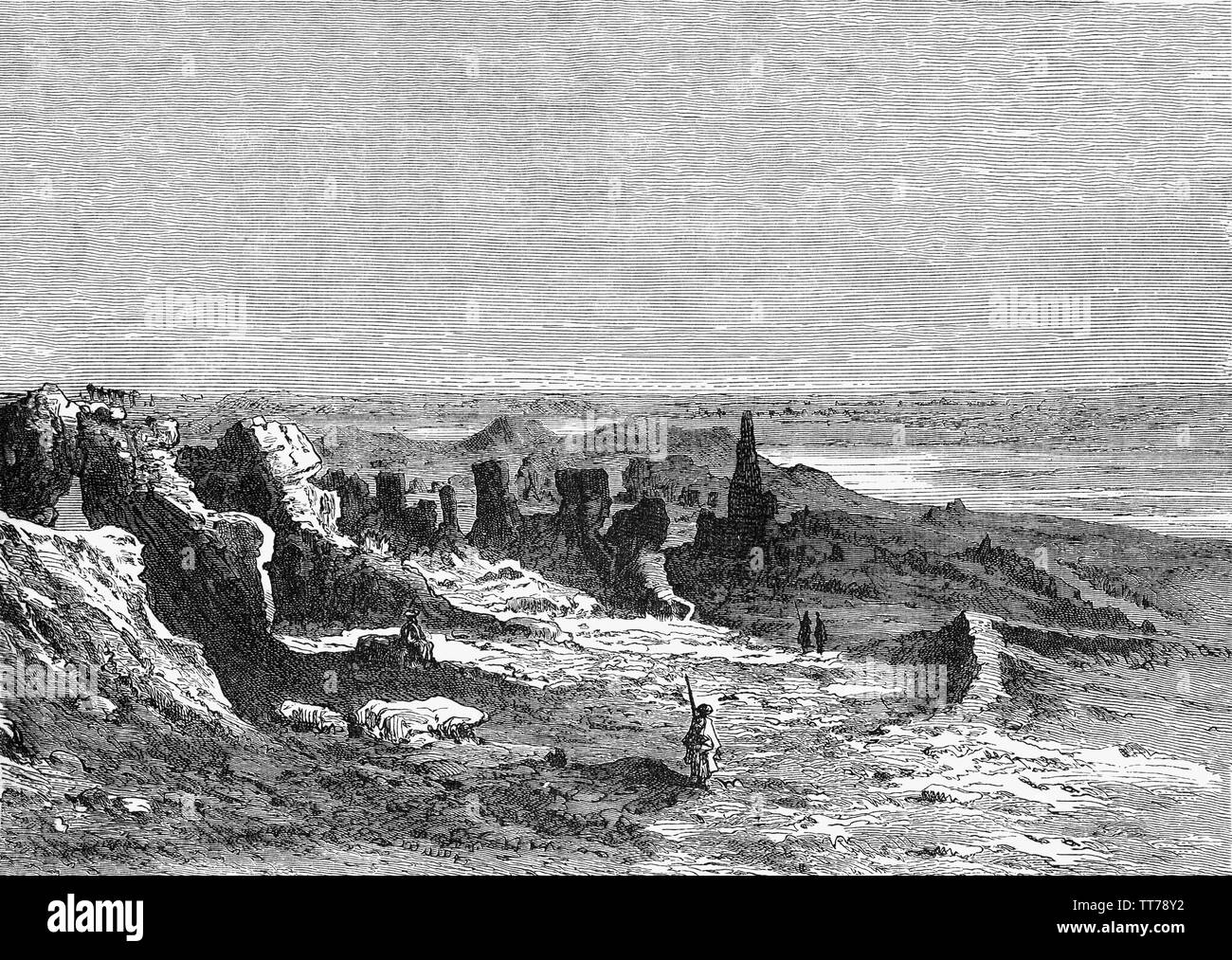 The ruins at Sais, an ancient Egyptian town in the Western Nile Delta. It was the provincial capital of Sap-Meh, the fifth nome of Lower Egypt and became the seat of power during the Twenty-fourth Dynasty of Egypt (c. 732–720 BC) and the Saite Twenty-sixth Dynasty of Egypt (664–525 BC) during the Late Period. The Temple of Sais had a medical school with many female students and apparently women faculty as well, mainly in gynecology and obstetrics. Stock Photohttps://www.alamy.com/image-license-details/?v=1https://www.alamy.com/the-ruins-at-sais-an-ancient-egyptian-town-in-the-western-nile-delta-it-was-the-provincial-capital-of-sap-meh-the-fifth-nome-of-lower-egypt-and-became-the-seat-of-power-during-the-twenty-fourth-dynasty-of-egypt-c-732720-bc-and-the-saite-twenty-sixth-dynasty-of-egypt-664525-bc-during-the-late-period-the-temple-of-sais-had-a-medical-school-with-many-female-students-and-apparently-women-faculty-as-well-mainly-in-gynecology-and-obstetrics-image255857590.html
The ruins at Sais, an ancient Egyptian town in the Western Nile Delta. It was the provincial capital of Sap-Meh, the fifth nome of Lower Egypt and became the seat of power during the Twenty-fourth Dynasty of Egypt (c. 732–720 BC) and the Saite Twenty-sixth Dynasty of Egypt (664–525 BC) during the Late Period. The Temple of Sais had a medical school with many female students and apparently women faculty as well, mainly in gynecology and obstetrics. Stock Photohttps://www.alamy.com/image-license-details/?v=1https://www.alamy.com/the-ruins-at-sais-an-ancient-egyptian-town-in-the-western-nile-delta-it-was-the-provincial-capital-of-sap-meh-the-fifth-nome-of-lower-egypt-and-became-the-seat-of-power-during-the-twenty-fourth-dynasty-of-egypt-c-732720-bc-and-the-saite-twenty-sixth-dynasty-of-egypt-664525-bc-during-the-late-period-the-temple-of-sais-had-a-medical-school-with-many-female-students-and-apparently-women-faculty-as-well-mainly-in-gynecology-and-obstetrics-image255857590.htmlRMTT78Y2–The ruins at Sais, an ancient Egyptian town in the Western Nile Delta. It was the provincial capital of Sap-Meh, the fifth nome of Lower Egypt and became the seat of power during the Twenty-fourth Dynasty of Egypt (c. 732–720 BC) and the Saite Twenty-sixth Dynasty of Egypt (664–525 BC) during the Late Period. The Temple of Sais had a medical school with many female students and apparently women faculty as well, mainly in gynecology and obstetrics.
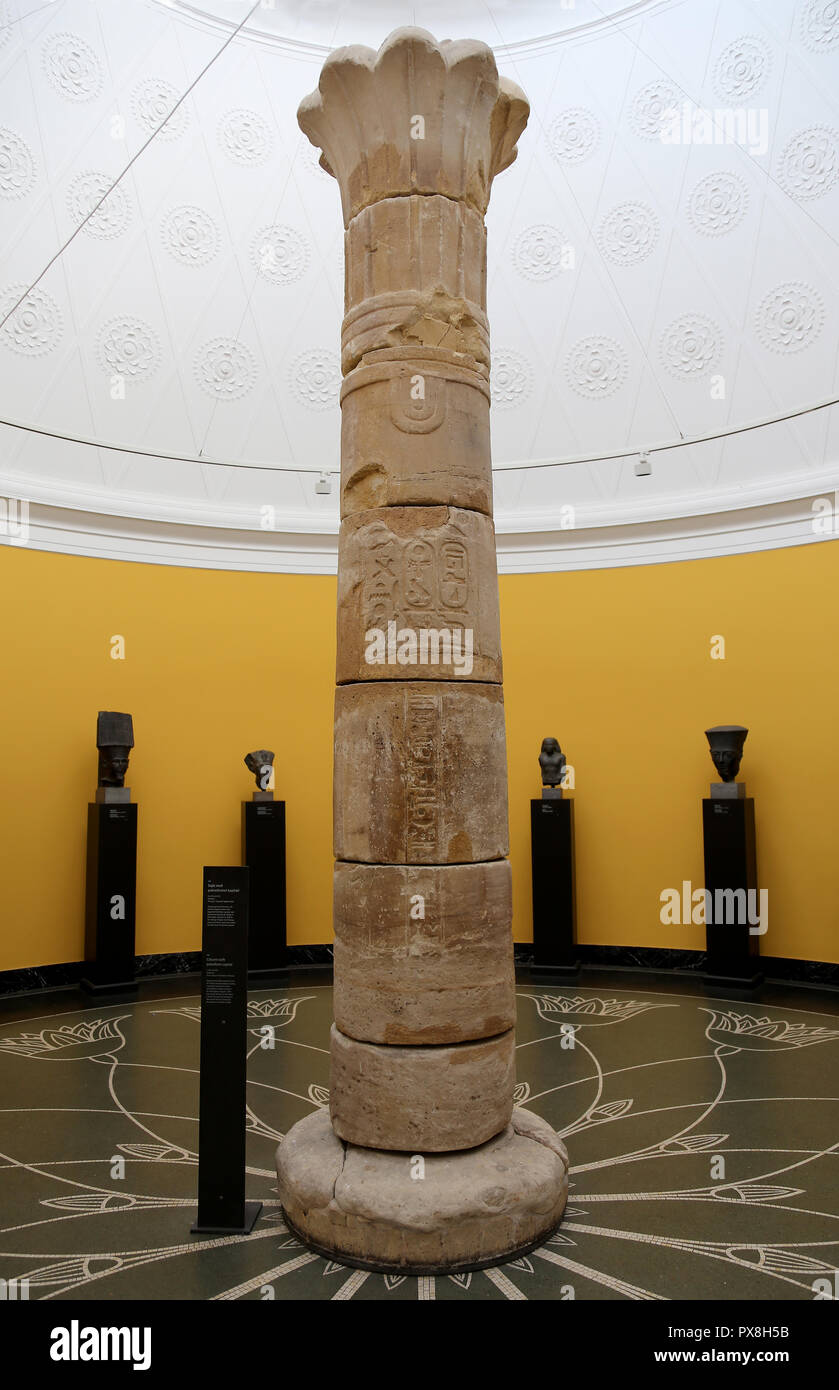 Column with palmiform capital (c. 690-664 BC) from the Temple of Taharqa, pharaoh of the 25th Dynasty, in Kawa, Ancient Egypt. Stock Photohttps://www.alamy.com/image-license-details/?v=1https://www.alamy.com/column-with-palmiform-capital-c-690-664-bc-from-the-temple-of-taharqa-pharaoh-of-the-25th-dynasty-in-kawa-ancient-egypt-image222694567.html
Column with palmiform capital (c. 690-664 BC) from the Temple of Taharqa, pharaoh of the 25th Dynasty, in Kawa, Ancient Egypt. Stock Photohttps://www.alamy.com/image-license-details/?v=1https://www.alamy.com/column-with-palmiform-capital-c-690-664-bc-from-the-temple-of-taharqa-pharaoh-of-the-25th-dynasty-in-kawa-ancient-egypt-image222694567.htmlRMPX8H5B–Column with palmiform capital (c. 690-664 BC) from the Temple of Taharqa, pharaoh of the 25th Dynasty, in Kawa, Ancient Egypt.
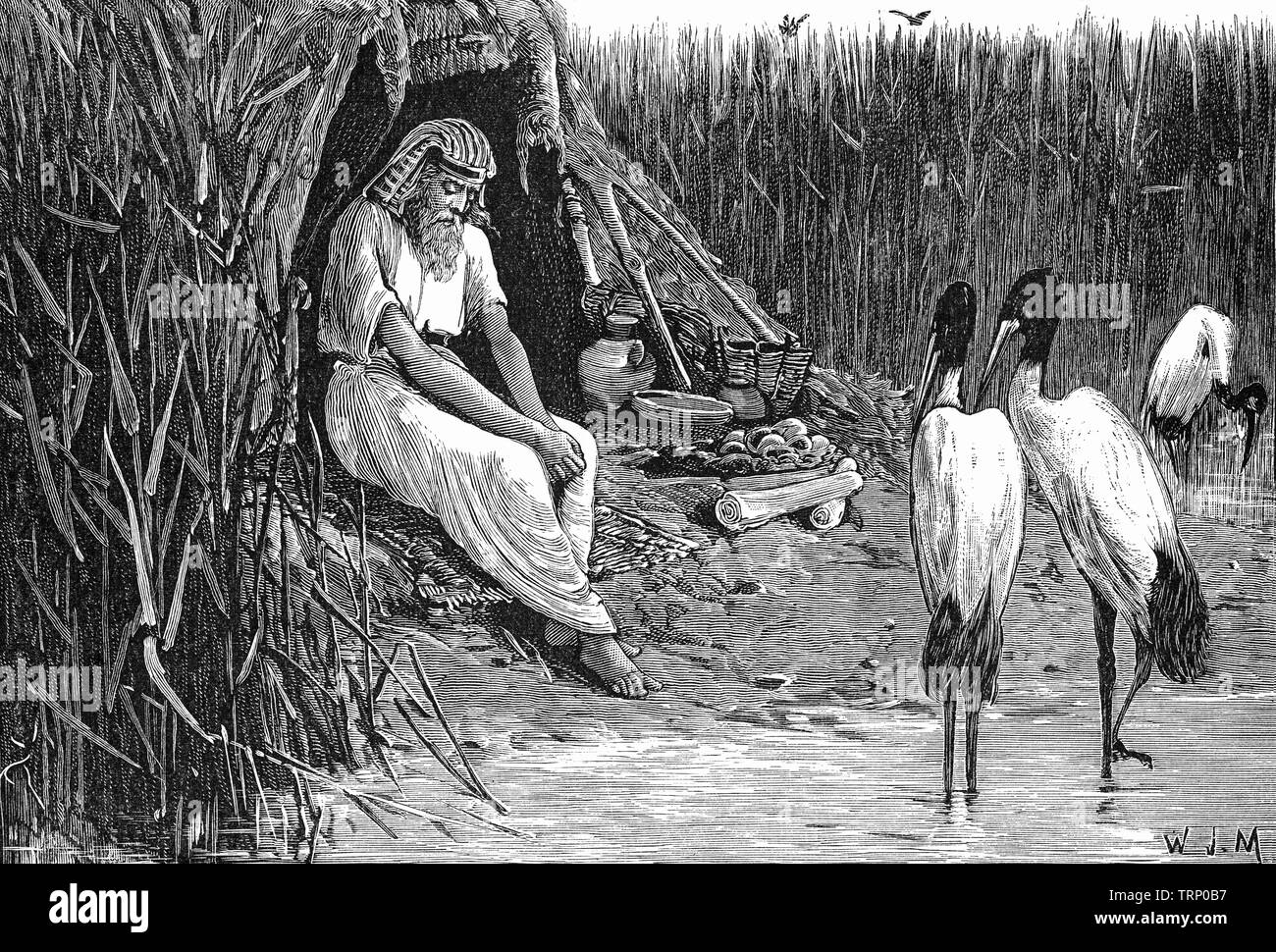 When Sabaco , an Etheopian conquered Egypt around 744 BC to create the 25th Dynasty, Anysis, a blind king took to an island in the marshes of the Nile delta where he stayed for the duration of Sabaco's reign. Stock Photohttps://www.alamy.com/image-license-details/?v=1https://www.alamy.com/when-sabaco-an-etheopian-conquered-egypt-around-744-bc-to-create-the-25th-dynasty-anysis-a-blind-king-took-to-an-island-in-the-marshes-of-the-nile-delta-where-he-stayed-for-the-duration-of-sabacos-reign-image255565499.html
When Sabaco , an Etheopian conquered Egypt around 744 BC to create the 25th Dynasty, Anysis, a blind king took to an island in the marshes of the Nile delta where he stayed for the duration of Sabaco's reign. Stock Photohttps://www.alamy.com/image-license-details/?v=1https://www.alamy.com/when-sabaco-an-etheopian-conquered-egypt-around-744-bc-to-create-the-25th-dynasty-anysis-a-blind-king-took-to-an-island-in-the-marshes-of-the-nile-delta-where-he-stayed-for-the-duration-of-sabacos-reign-image255565499.htmlRMTRP0B7–When Sabaco , an Etheopian conquered Egypt around 744 BC to create the 25th Dynasty, Anysis, a blind king took to an island in the marshes of the Nile delta where he stayed for the duration of Sabaco's reign.
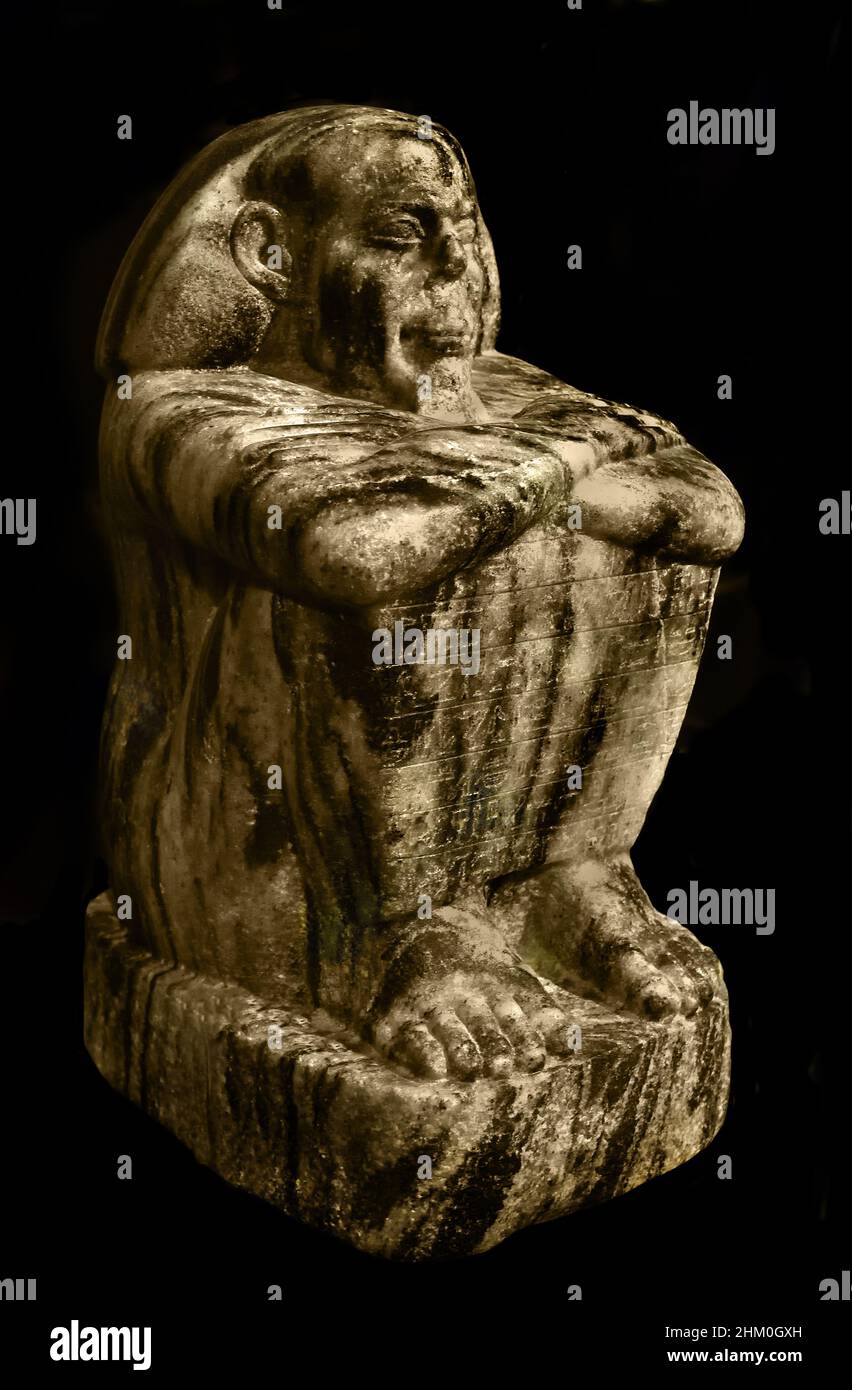 Block statue of the priest Merenptah, Stone / gneiss, 40 x 20 x 27 cm, 722–664 BC, Twenty-fifth 25th, Dynasty, Egypt (Museo Egizio di Torino Italy) Stock Photohttps://www.alamy.com/image-license-details/?v=1https://www.alamy.com/block-statue-of-the-priest-merenptah-stone-gneiss-40-x-20-x-27-cm-722664-bc-twenty-fifth-25th-dynasty-egypt-museo-egizio-di-torino-italy-image459775977.html
Block statue of the priest Merenptah, Stone / gneiss, 40 x 20 x 27 cm, 722–664 BC, Twenty-fifth 25th, Dynasty, Egypt (Museo Egizio di Torino Italy) Stock Photohttps://www.alamy.com/image-license-details/?v=1https://www.alamy.com/block-statue-of-the-priest-merenptah-stone-gneiss-40-x-20-x-27-cm-722664-bc-twenty-fifth-25th-dynasty-egypt-museo-egizio-di-torino-italy-image459775977.htmlRM2HM0GXH–Block statue of the priest Merenptah, Stone / gneiss, 40 x 20 x 27 cm, 722–664 BC, Twenty-fifth 25th, Dynasty, Egypt (Museo Egizio di Torino Italy)
 Old engraved illustration of the Sarcophagus of Mummy of Seracher, who was the nurse of King Taraks of twenty-fifth dynasty, 700 years before Christian era (Museum of Florence). Dictionary of words and things - Larive and Fleury ? 1895 Stock Photohttps://www.alamy.com/image-license-details/?v=1https://www.alamy.com/stock-photo-old-engraved-illustration-of-the-sarcophagus-of-mummy-of-seracher-43484831.html
Old engraved illustration of the Sarcophagus of Mummy of Seracher, who was the nurse of King Taraks of twenty-fifth dynasty, 700 years before Christian era (Museum of Florence). Dictionary of words and things - Larive and Fleury ? 1895 Stock Photohttps://www.alamy.com/image-license-details/?v=1https://www.alamy.com/stock-photo-old-engraved-illustration-of-the-sarcophagus-of-mummy-of-seracher-43484831.htmlRFCEMW9K–Old engraved illustration of the Sarcophagus of Mummy of Seracher, who was the nurse of King Taraks of twenty-fifth dynasty, 700 years before Christian era (Museum of Florence). Dictionary of words and things - Larive and Fleury ? 1895
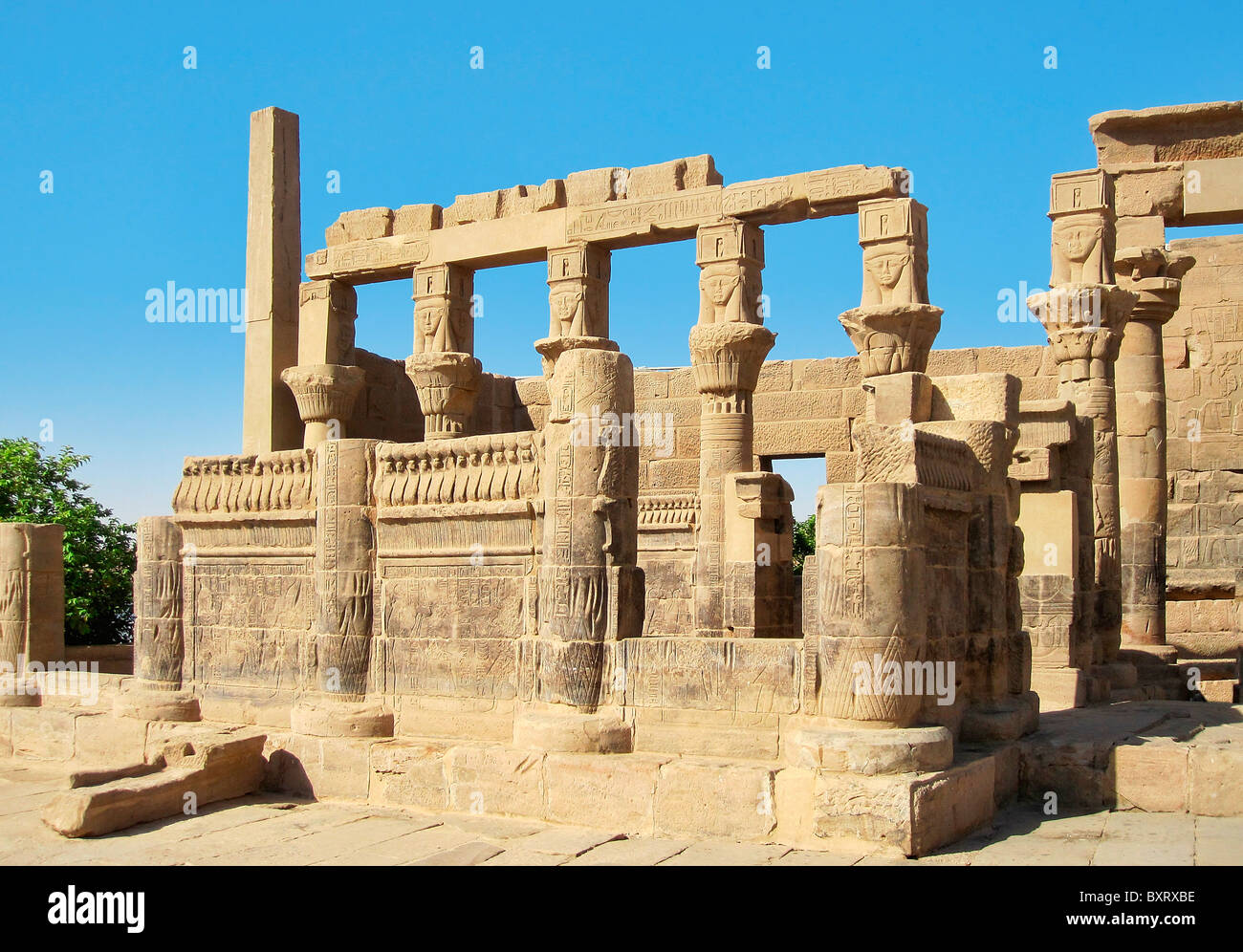 Philae Temple, Egypt Stock Photohttps://www.alamy.com/image-license-details/?v=1https://www.alamy.com/stock-photo-philae-temple-egypt-33717026.html
Philae Temple, Egypt Stock Photohttps://www.alamy.com/image-license-details/?v=1https://www.alamy.com/stock-photo-philae-temple-egypt-33717026.htmlRFBXRXBE–Philae Temple, Egypt
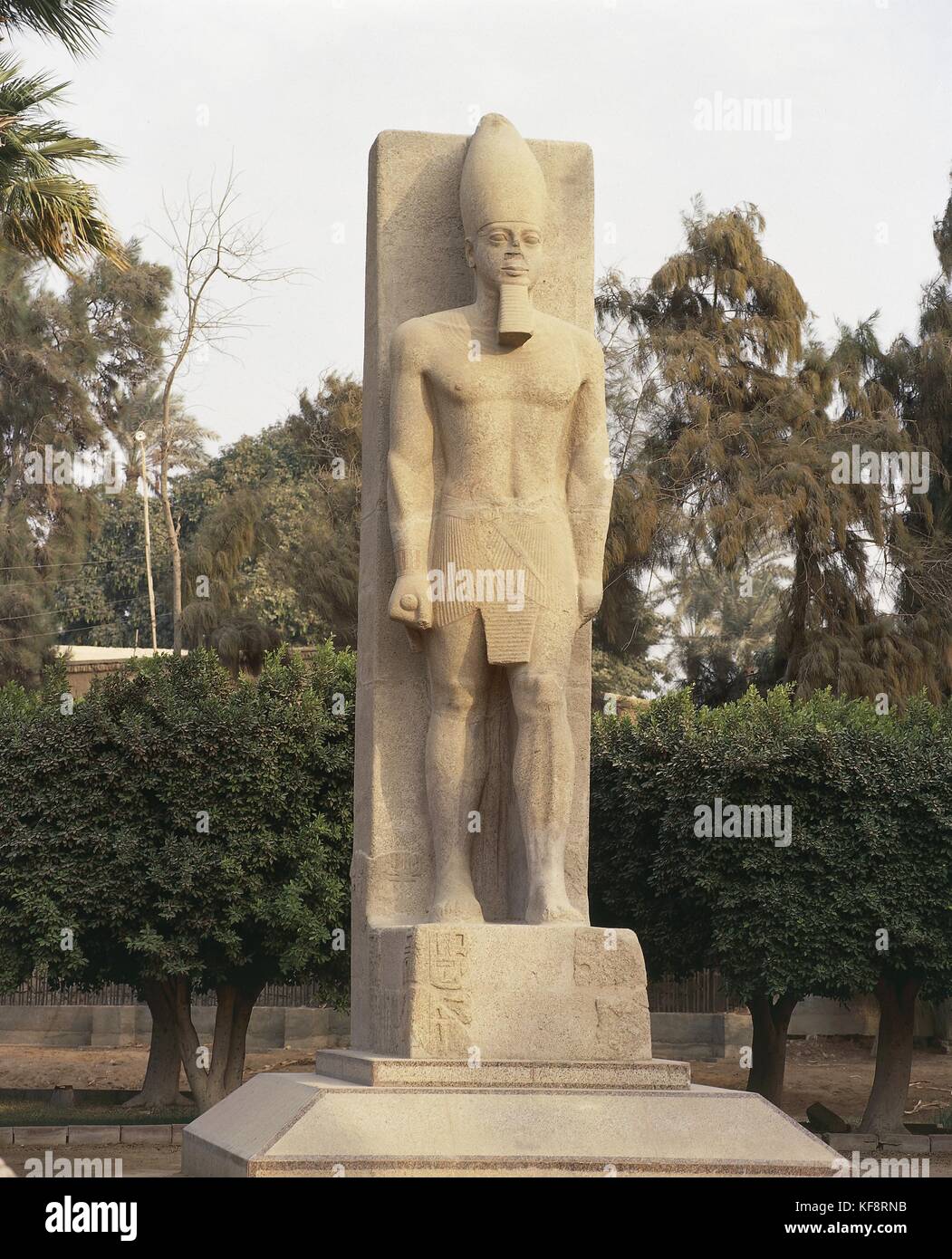 Egypt, Cairo, Ancient Memphis (UNESCO World Heritage List, 1979). Statue of Pharaoh king, 25th Dynasty, in temple of Ptah Stock Photohttps://www.alamy.com/image-license-details/?v=1https://www.alamy.com/stock-image-egypt-cairo-ancient-memphis-unesco-world-heritage-list-1979-statue-164307399.html
Egypt, Cairo, Ancient Memphis (UNESCO World Heritage List, 1979). Statue of Pharaoh king, 25th Dynasty, in temple of Ptah Stock Photohttps://www.alamy.com/image-license-details/?v=1https://www.alamy.com/stock-image-egypt-cairo-ancient-memphis-unesco-world-heritage-list-1979-statue-164307399.htmlRFKF8RNB–Egypt, Cairo, Ancient Memphis (UNESCO World Heritage List, 1979). Statue of Pharaoh king, 25th Dynasty, in temple of Ptah
 Old engraved illustration of the Sarcophagus of Mummy of Seracher, who was the nurse of King Taraks of twenty-fifth dynasty, 700 Stock Vectorhttps://www.alamy.com/image-license-details/?v=1https://www.alamy.com/stock-photo-old-engraved-illustration-of-the-sarcophagus-of-mummy-of-seracher-84420347.html
Old engraved illustration of the Sarcophagus of Mummy of Seracher, who was the nurse of King Taraks of twenty-fifth dynasty, 700 Stock Vectorhttps://www.alamy.com/image-license-details/?v=1https://www.alamy.com/stock-photo-old-engraved-illustration-of-the-sarcophagus-of-mummy-of-seracher-84420347.htmlRFEW9K0B–Old engraved illustration of the Sarcophagus of Mummy of Seracher, who was the nurse of King Taraks of twenty-fifth dynasty, 700
 Philae Temple Egypt number 3027 Stock Photohttps://www.alamy.com/image-license-details/?v=1https://www.alamy.com/stock-photo-philae-temple-egypt-number-3027-43567019.html
Philae Temple Egypt number 3027 Stock Photohttps://www.alamy.com/image-license-details/?v=1https://www.alamy.com/stock-photo-philae-temple-egypt-number-3027-43567019.htmlRMCETJ4Y–Philae Temple Egypt number 3027
 Amulet of the God Horus. Egyptian. Date: 780 BC-343 BC. Dimensions: 1.5 × 1 × .25 cm (9/16 × 3/8 × 1/16 in.). Faience. Origin: Egypt. Museum: The Chicago Art Institute. Author: Ancient Egyptian. Stock Photohttps://www.alamy.com/image-license-details/?v=1https://www.alamy.com/amulet-of-the-god-horus-egyptian-date-780-bc-343-bc-dimensions-15-1-25-cm-916-38-116-in-faience-origin-egypt-museum-the-chicago-art-institute-author-ancient-egyptian-image239866476.html
Amulet of the God Horus. Egyptian. Date: 780 BC-343 BC. Dimensions: 1.5 × 1 × .25 cm (9/16 × 3/8 × 1/16 in.). Faience. Origin: Egypt. Museum: The Chicago Art Institute. Author: Ancient Egyptian. Stock Photohttps://www.alamy.com/image-license-details/?v=1https://www.alamy.com/amulet-of-the-god-horus-egyptian-date-780-bc-343-bc-dimensions-15-1-25-cm-916-38-116-in-faience-origin-egypt-museum-the-chicago-art-institute-author-ancient-egyptian-image239866476.htmlRMRX6T3T–Amulet of the God Horus. Egyptian. Date: 780 BC-343 BC. Dimensions: 1.5 × 1 × .25 cm (9/16 × 3/8 × 1/16 in.). Faience. Origin: Egypt. Museum: The Chicago Art Institute. Author: Ancient Egyptian.
 Philae temple in Egypt Stock Photohttps://www.alamy.com/image-license-details/?v=1https://www.alamy.com/philae-temple-in-egypt-image359740212.html
Philae temple in Egypt Stock Photohttps://www.alamy.com/image-license-details/?v=1https://www.alamy.com/philae-temple-in-egypt-image359740212.htmlRF2BW7G8M–Philae temple in Egypt
 The outer coffin lid of Iawttayesheret, known as Tayesheret, is displayed at the Michael C. Carlos Museum at Emory University in Atlanta, Georgia. Stock Photohttps://www.alamy.com/image-license-details/?v=1https://www.alamy.com/the-outer-coffin-lid-of-iawttayesheret-known-as-tayesheret-is-displayed-at-the-michael-c-carlos-museum-at-emory-university-in-atlanta-georgia-image227973120.html
The outer coffin lid of Iawttayesheret, known as Tayesheret, is displayed at the Michael C. Carlos Museum at Emory University in Atlanta, Georgia. Stock Photohttps://www.alamy.com/image-license-details/?v=1https://www.alamy.com/the-outer-coffin-lid-of-iawttayesheret-known-as-tayesheret-is-displayed-at-the-michael-c-carlos-museum-at-emory-university-in-atlanta-georgia-image227973120.htmlRMR6W214–The outer coffin lid of Iawttayesheret, known as Tayesheret, is displayed at the Michael C. Carlos Museum at Emory University in Atlanta, Georgia.
 Stela of princess Paabtameri. 25th Egyptian dynasty The princess is depicted in supplication to teh God ra-Harakte on an Egyptian stela. Princess Paabtameri was a member of the Nubian royal family of the 25th Egyptian dynasty. The Twenty-Fifth Dynasty of Egypt, also known as the Nubian dynasty or Kushite Empire, was a line of rulers originating in the Kingdom of Kush. They reigned in part or all of Ancient Egypt from 760 BC to 656 BC. Stock Photohttps://www.alamy.com/image-license-details/?v=1https://www.alamy.com/stock-photo-stela-of-princess-paabtameri-25th-egyptian-dynasty-the-princess-is-57345318.html
Stela of princess Paabtameri. 25th Egyptian dynasty The princess is depicted in supplication to teh God ra-Harakte on an Egyptian stela. Princess Paabtameri was a member of the Nubian royal family of the 25th Egyptian dynasty. The Twenty-Fifth Dynasty of Egypt, also known as the Nubian dynasty or Kushite Empire, was a line of rulers originating in the Kingdom of Kush. They reigned in part or all of Ancient Egypt from 760 BC to 656 BC. Stock Photohttps://www.alamy.com/image-license-details/?v=1https://www.alamy.com/stock-photo-stela-of-princess-paabtameri-25th-egyptian-dynasty-the-princess-is-57345318.htmlRMD988F2–Stela of princess Paabtameri. 25th Egyptian dynasty The princess is depicted in supplication to teh God ra-Harakte on an Egyptian stela. Princess Paabtameri was a member of the Nubian royal family of the 25th Egyptian dynasty. The Twenty-Fifth Dynasty of Egypt, also known as the Nubian dynasty or Kushite Empire, was a line of rulers originating in the Kingdom of Kush. They reigned in part or all of Ancient Egypt from 760 BC to 656 BC.
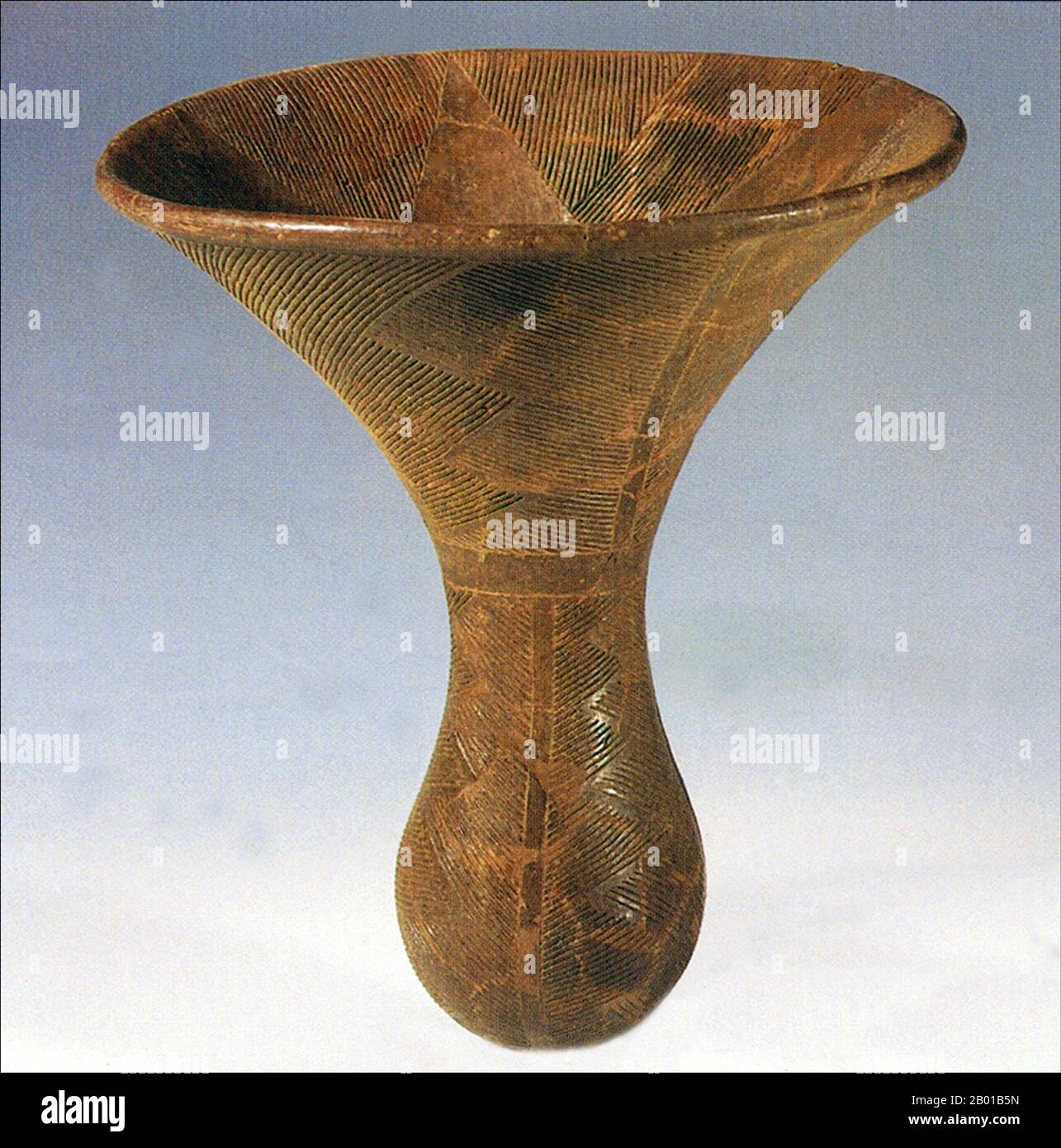 Sudan: A neolithic libation vessel from al-Kadada, near Shendi, c. 3500 BCE. The Kingdom of Kush or Cush was an ancient Nubian state centred on the confluences of the Blue Nile, White Nile and River Atbara in what is now the Republic of Sudan. Established after the Bronze Age collapse and the disintegration of the New Kingdom of Egypt, it was centered at Napata in its early phase. After King Kashta ('the Kushite') invaded Egypt in the 8th century BCE, the Kushite kings ruled as Pharaohs of the Twenty-fifth dynasty of Egypt for a century, until they were expelled by Psamtik I in 656 BCE. Stock Photohttps://www.alamy.com/image-license-details/?v=1https://www.alamy.com/sudan-a-neolithic-libation-vessel-from-al-kadada-near-shendi-c-3500-bce-the-kingdom-of-kush-or-cush-was-an-ancient-nubian-state-centred-on-the-confluences-of-the-blue-nile-white-nile-and-river-atbara-in-what-is-now-the-republic-of-sudan-established-after-the-bronze-age-collapse-and-the-disintegration-of-the-new-kingdom-of-egypt-it-was-centered-at-napata-in-its-early-phase-after-king-kashta-the-kushite-invaded-egypt-in-the-8th-century-bce-the-kushite-kings-ruled-as-pharaohs-of-the-twenty-fifth-dynasty-of-egypt-for-a-century-until-they-were-expelled-by-psamtik-i-in-656-bce-image344238097.html
Sudan: A neolithic libation vessel from al-Kadada, near Shendi, c. 3500 BCE. The Kingdom of Kush or Cush was an ancient Nubian state centred on the confluences of the Blue Nile, White Nile and River Atbara in what is now the Republic of Sudan. Established after the Bronze Age collapse and the disintegration of the New Kingdom of Egypt, it was centered at Napata in its early phase. After King Kashta ('the Kushite') invaded Egypt in the 8th century BCE, the Kushite kings ruled as Pharaohs of the Twenty-fifth dynasty of Egypt for a century, until they were expelled by Psamtik I in 656 BCE. Stock Photohttps://www.alamy.com/image-license-details/?v=1https://www.alamy.com/sudan-a-neolithic-libation-vessel-from-al-kadada-near-shendi-c-3500-bce-the-kingdom-of-kush-or-cush-was-an-ancient-nubian-state-centred-on-the-confluences-of-the-blue-nile-white-nile-and-river-atbara-in-what-is-now-the-republic-of-sudan-established-after-the-bronze-age-collapse-and-the-disintegration-of-the-new-kingdom-of-egypt-it-was-centered-at-napata-in-its-early-phase-after-king-kashta-the-kushite-invaded-egypt-in-the-8th-century-bce-the-kushite-kings-ruled-as-pharaohs-of-the-twenty-fifth-dynasty-of-egypt-for-a-century-until-they-were-expelled-by-psamtik-i-in-656-bce-image344238097.htmlRM2B01B5N–Sudan: A neolithic libation vessel from al-Kadada, near Shendi, c. 3500 BCE. The Kingdom of Kush or Cush was an ancient Nubian state centred on the confluences of the Blue Nile, White Nile and River Atbara in what is now the Republic of Sudan. Established after the Bronze Age collapse and the disintegration of the New Kingdom of Egypt, it was centered at Napata in its early phase. After King Kashta ('the Kushite') invaded Egypt in the 8th century BCE, the Kushite kings ruled as Pharaohs of the Twenty-fifth dynasty of Egypt for a century, until they were expelled by Psamtik I in 656 BCE.
 Twenty-Fifth Dynasty, 690-664 BC. From Kawa in Nubia. The worship of Amun, imported into Nubia by the Egyptians was carried on with great zeal by the royal family of the twenty-fifth Dynasty. This statue symbolizes the god's protection of the king. Stock Photohttps://www.alamy.com/image-license-details/?v=1https://www.alamy.com/stock-photo-twenty-fifth-dynasty-690-664-bc-from-kawa-in-nubia-the-worship-of-76387187.html
Twenty-Fifth Dynasty, 690-664 BC. From Kawa in Nubia. The worship of Amun, imported into Nubia by the Egyptians was carried on with great zeal by the royal family of the twenty-fifth Dynasty. This statue symbolizes the god's protection of the king. Stock Photohttps://www.alamy.com/image-license-details/?v=1https://www.alamy.com/stock-photo-twenty-fifth-dynasty-690-664-bc-from-kawa-in-nubia-the-worship-of-76387187.htmlRMEC7MHR–Twenty-Fifth Dynasty, 690-664 BC. From Kawa in Nubia. The worship of Amun, imported into Nubia by the Egyptians was carried on with great zeal by the royal family of the twenty-fifth Dynasty. This statue symbolizes the god's protection of the king.
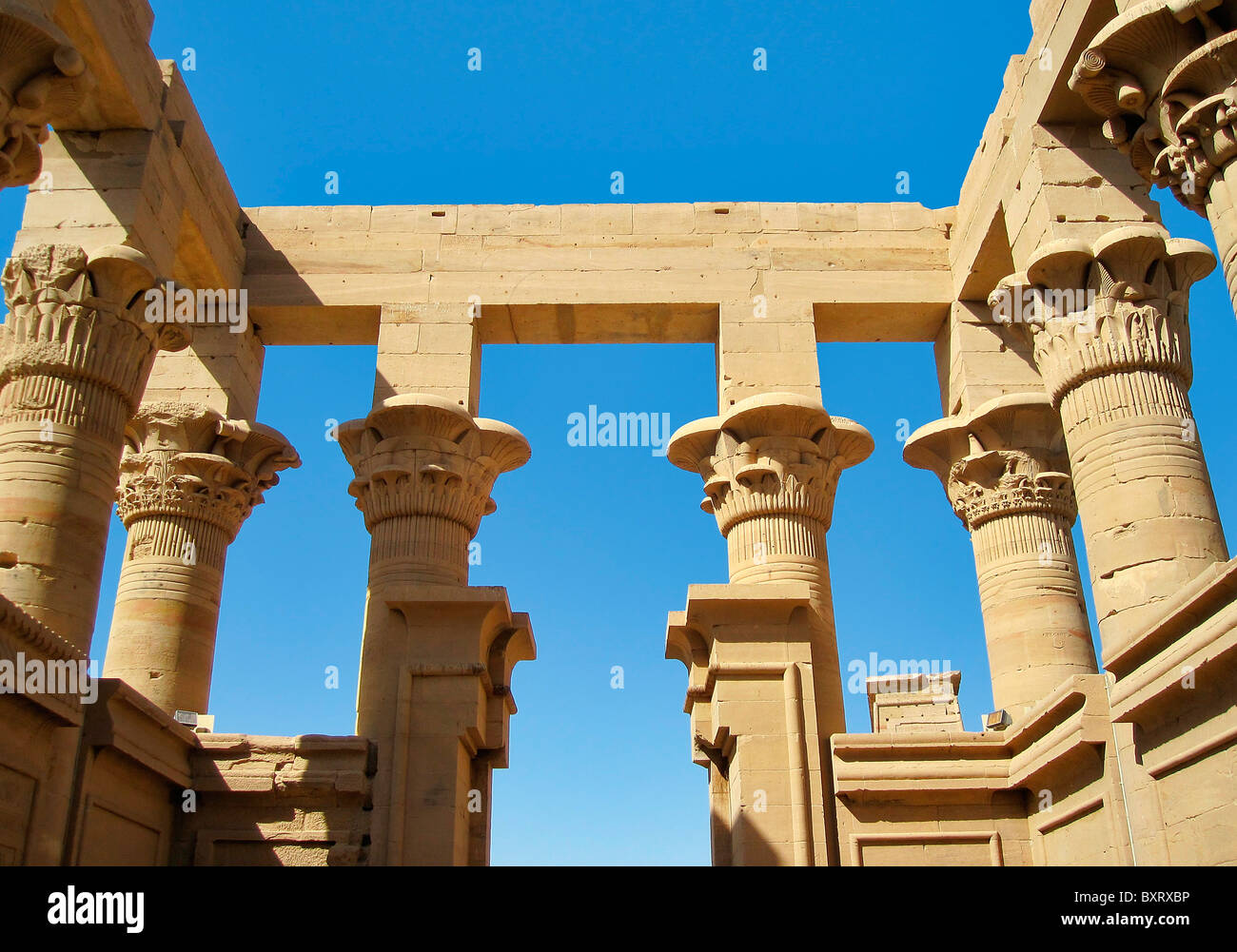 Philae Temple, Egypt Stock Photohttps://www.alamy.com/image-license-details/?v=1https://www.alamy.com/stock-photo-philae-temple-egypt-33717034.html
Philae Temple, Egypt Stock Photohttps://www.alamy.com/image-license-details/?v=1https://www.alamy.com/stock-photo-philae-temple-egypt-33717034.htmlRFBXRXBP–Philae Temple, Egypt
 Old engraved illustration of the Sarcophagus of Mummy of Seracher, who was the nurse of King Taraks of twenty-fifth dynasty, 700 Stock Vectorhttps://www.alamy.com/image-license-details/?v=1https://www.alamy.com/stock-photo-old-engraved-illustration-of-the-sarcophagus-of-mummy-of-seracher-84409840.html
Old engraved illustration of the Sarcophagus of Mummy of Seracher, who was the nurse of King Taraks of twenty-fifth dynasty, 700 Stock Vectorhttps://www.alamy.com/image-license-details/?v=1https://www.alamy.com/stock-photo-old-engraved-illustration-of-the-sarcophagus-of-mummy-of-seracher-84409840.htmlRFEW95H4–Old engraved illustration of the Sarcophagus of Mummy of Seracher, who was the nurse of King Taraks of twenty-fifth dynasty, 700
 Philae Temple Egypt number 3024 Stock Photohttps://www.alamy.com/image-license-details/?v=1https://www.alamy.com/stock-photo-philae-temple-egypt-number-3024-43566470.html
Philae Temple Egypt number 3024 Stock Photohttps://www.alamy.com/image-license-details/?v=1https://www.alamy.com/stock-photo-philae-temple-egypt-number-3024-43566470.htmlRMCETHDA–Philae Temple Egypt number 3024
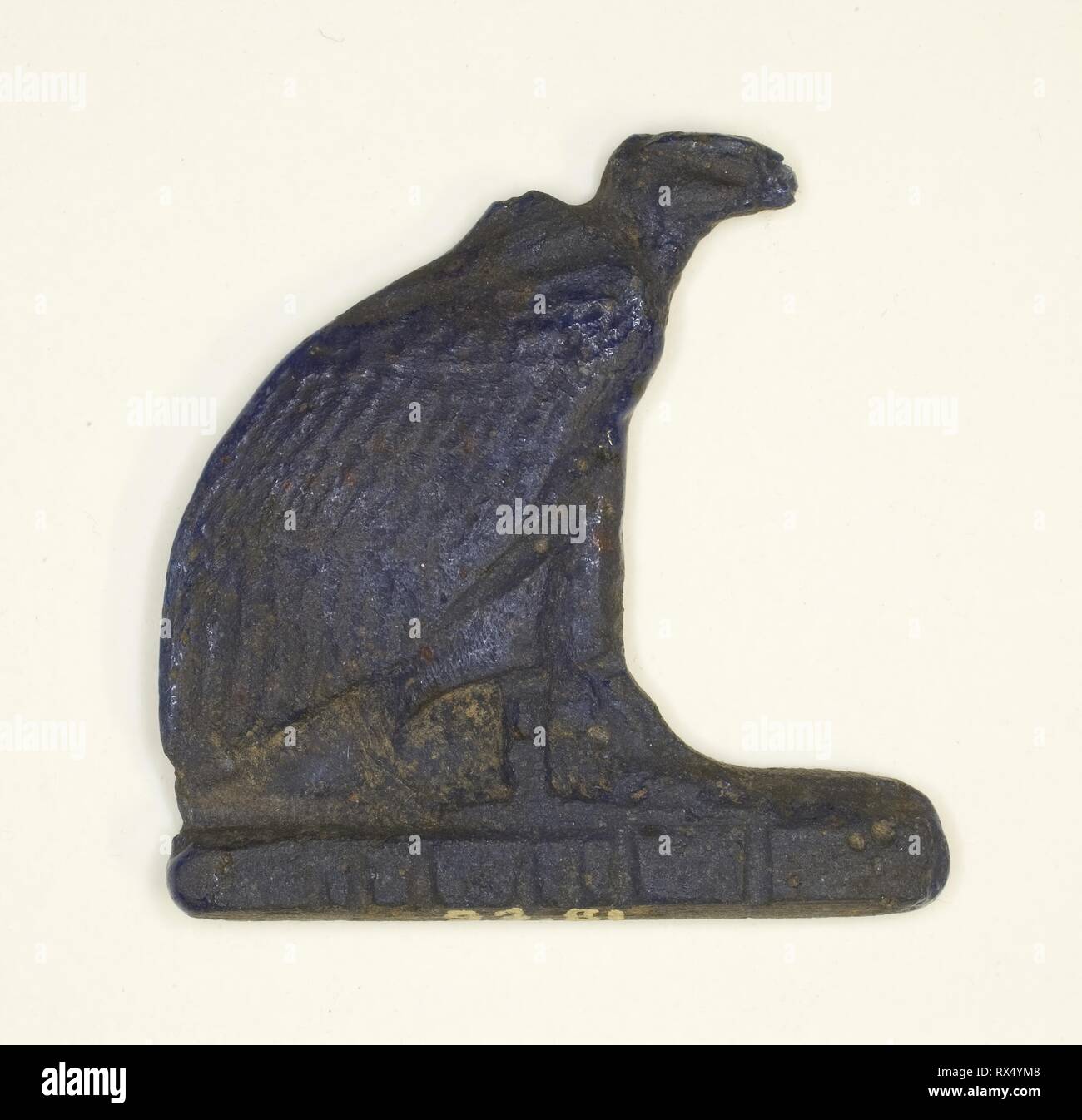 Amulet of a Vulture. Egyptian. Date: 780 BC-343 BC. Dimensions: 3.18 × 3 × .32 cm (1 1/4 × 1 3/16 × 1/8 in.). Glass. Origin: Egypt. Museum: The Chicago Art Institute. Author: Ancient Egyptian. Stock Photohttps://www.alamy.com/image-license-details/?v=1https://www.alamy.com/amulet-of-a-vulture-egyptian-date-780-bc-343-bc-dimensions-318-3-32-cm-1-14-1-316-18-in-glass-origin-egypt-museum-the-chicago-art-institute-author-ancient-egyptian-image239825384.html
Amulet of a Vulture. Egyptian. Date: 780 BC-343 BC. Dimensions: 3.18 × 3 × .32 cm (1 1/4 × 1 3/16 × 1/8 in.). Glass. Origin: Egypt. Museum: The Chicago Art Institute. Author: Ancient Egyptian. Stock Photohttps://www.alamy.com/image-license-details/?v=1https://www.alamy.com/amulet-of-a-vulture-egyptian-date-780-bc-343-bc-dimensions-318-3-32-cm-1-14-1-316-18-in-glass-origin-egypt-museum-the-chicago-art-institute-author-ancient-egyptian-image239825384.htmlRMRX4YM8–Amulet of a Vulture. Egyptian. Date: 780 BC-343 BC. Dimensions: 3.18 × 3 × .32 cm (1 1/4 × 1 3/16 × 1/8 in.). Glass. Origin: Egypt. Museum: The Chicago Art Institute. Author: Ancient Egyptian.
 Philae Temple Egypt number 3028 Stock Photohttps://www.alamy.com/image-license-details/?v=1https://www.alamy.com/stock-photo-philae-temple-egypt-number-3028-43566808.html
Philae Temple Egypt number 3028 Stock Photohttps://www.alamy.com/image-license-details/?v=1https://www.alamy.com/stock-photo-philae-temple-egypt-number-3028-43566808.htmlRMCETHWC–Philae Temple Egypt number 3028
 Foundation Deposit: Bound Ox. Egyptian. Date: 780 BC-343 BC. Dimensions: 2.5 × 4 × .25 cm (1 × 1 9/16 × 1/8 in.). Glass. Origin: Egypt. Museum: The Chicago Art Institute. Author: Ancient Egyptian. Stock Photohttps://www.alamy.com/image-license-details/?v=1https://www.alamy.com/foundation-deposit-bound-ox-egyptian-date-780-bc-343-bc-dimensions-25-4-25-cm-1-1-916-18-in-glass-origin-egypt-museum-the-chicago-art-institute-author-ancient-egyptian-image239740514.html
Foundation Deposit: Bound Ox. Egyptian. Date: 780 BC-343 BC. Dimensions: 2.5 × 4 × .25 cm (1 × 1 9/16 × 1/8 in.). Glass. Origin: Egypt. Museum: The Chicago Art Institute. Author: Ancient Egyptian. Stock Photohttps://www.alamy.com/image-license-details/?v=1https://www.alamy.com/foundation-deposit-bound-ox-egyptian-date-780-bc-343-bc-dimensions-25-4-25-cm-1-1-916-18-in-glass-origin-egypt-museum-the-chicago-art-institute-author-ancient-egyptian-image239740514.htmlRMRX13D6–Foundation Deposit: Bound Ox. Egyptian. Date: 780 BC-343 BC. Dimensions: 2.5 × 4 × .25 cm (1 × 1 9/16 × 1/8 in.). Glass. Origin: Egypt. Museum: The Chicago Art Institute. Author: Ancient Egyptian.
 Philae Temple Egypt number 3025 Stock Photohttps://www.alamy.com/image-license-details/?v=1https://www.alamy.com/stock-photo-philae-temple-egypt-number-3025-43566236.html
Philae Temple Egypt number 3025 Stock Photohttps://www.alamy.com/image-license-details/?v=1https://www.alamy.com/stock-photo-philae-temple-egypt-number-3025-43566236.htmlRMCETH50–Philae Temple Egypt number 3025
 Amulet of a Jackal-Headed God. Egyptian. Date: 780 BC-343 BC. Dimensions: 4.5 × 1 × .5 cm (1 1/4 × 3/8 × 3/16 in.). Glass. Origin: Egypt. Museum: The Chicago Art Institute. Author: Ancient Egyptian. Stock Photohttps://www.alamy.com/image-license-details/?v=1https://www.alamy.com/amulet-of-a-jackal-headed-god-egyptian-date-780-bc-343-bc-dimensions-45-1-5-cm-1-14-38-316-in-glass-origin-egypt-museum-the-chicago-art-institute-author-ancient-egyptian-image239825694.html
Amulet of a Jackal-Headed God. Egyptian. Date: 780 BC-343 BC. Dimensions: 4.5 × 1 × .5 cm (1 1/4 × 3/8 × 3/16 in.). Glass. Origin: Egypt. Museum: The Chicago Art Institute. Author: Ancient Egyptian. Stock Photohttps://www.alamy.com/image-license-details/?v=1https://www.alamy.com/amulet-of-a-jackal-headed-god-egyptian-date-780-bc-343-bc-dimensions-45-1-5-cm-1-14-38-316-in-glass-origin-egypt-museum-the-chicago-art-institute-author-ancient-egyptian-image239825694.htmlRMRX503A–Amulet of a Jackal-Headed God. Egyptian. Date: 780 BC-343 BC. Dimensions: 4.5 × 1 × .5 cm (1 1/4 × 3/8 × 3/16 in.). Glass. Origin: Egypt. Museum: The Chicago Art Institute. Author: Ancient Egyptian.
 Philae Temple Egypt number 3029 Stock Photohttps://www.alamy.com/image-license-details/?v=1https://www.alamy.com/stock-photo-philae-temple-egypt-number-3029-43566334.html
Philae Temple Egypt number 3029 Stock Photohttps://www.alamy.com/image-license-details/?v=1https://www.alamy.com/stock-photo-philae-temple-egypt-number-3029-43566334.htmlRMCETH8E–Philae Temple Egypt number 3029
 Amulet of the God Bes. Egyptian. Date: 1069 BC-664 BC. Dimensions: 2.7 × 1 × .64 cm (1 1/16 × 3/8 × 1/4 in.). Faience. Origin: Egypt. Museum: The Chicago Art Institute. Author: Ancient Egyptian. Stock Photohttps://www.alamy.com/image-license-details/?v=1https://www.alamy.com/amulet-of-the-god-bes-egyptian-date-1069-bc-664-bc-dimensions-27-1-64-cm-1-116-38-14-in-faience-origin-egypt-museum-the-chicago-art-institute-author-ancient-egyptian-image239836374.html
Amulet of the God Bes. Egyptian. Date: 1069 BC-664 BC. Dimensions: 2.7 × 1 × .64 cm (1 1/16 × 3/8 × 1/4 in.). Faience. Origin: Egypt. Museum: The Chicago Art Institute. Author: Ancient Egyptian. Stock Photohttps://www.alamy.com/image-license-details/?v=1https://www.alamy.com/amulet-of-the-god-bes-egyptian-date-1069-bc-664-bc-dimensions-27-1-64-cm-1-116-38-14-in-faience-origin-egypt-museum-the-chicago-art-institute-author-ancient-egyptian-image239836374.htmlRMRX5DMP–Amulet of the God Bes. Egyptian. Date: 1069 BC-664 BC. Dimensions: 2.7 × 1 × .64 cm (1 1/16 × 3/8 × 1/4 in.). Faience. Origin: Egypt. Museum: The Chicago Art Institute. Author: Ancient Egyptian.
 Philae Temple Egypt number 3026 Stock Photohttps://www.alamy.com/image-license-details/?v=1https://www.alamy.com/stock-photo-philae-temple-egypt-number-3026-43567167.html
Philae Temple Egypt number 3026 Stock Photohttps://www.alamy.com/image-license-details/?v=1https://www.alamy.com/stock-photo-philae-temple-egypt-number-3026-43567167.htmlRMCETJA7–Philae Temple Egypt number 3026
 Amulet of the Soul as a Human-Headed Bird. Egyptian. Date: 780 BC-343 BC. Dimensions: 3.5 × 3 × 0.5 cm (1 3/8 × 1 1/8 × 1/4 in.). Glass. Origin: Egypt. Museum: The Chicago Art Institute. Author: Ancient Egyptian. Stock Photohttps://www.alamy.com/image-license-details/?v=1https://www.alamy.com/amulet-of-the-soul-as-a-human-headed-bird-egyptian-date-780-bc-343-bc-dimensions-35-3-05-cm-1-38-1-18-14-in-glass-origin-egypt-museum-the-chicago-art-institute-author-ancient-egyptian-image239835948.html
Amulet of the Soul as a Human-Headed Bird. Egyptian. Date: 780 BC-343 BC. Dimensions: 3.5 × 3 × 0.5 cm (1 3/8 × 1 1/8 × 1/4 in.). Glass. Origin: Egypt. Museum: The Chicago Art Institute. Author: Ancient Egyptian. Stock Photohttps://www.alamy.com/image-license-details/?v=1https://www.alamy.com/amulet-of-the-soul-as-a-human-headed-bird-egyptian-date-780-bc-343-bc-dimensions-35-3-05-cm-1-38-1-18-14-in-glass-origin-egypt-museum-the-chicago-art-institute-author-ancient-egyptian-image239835948.htmlRMRX5D5G–Amulet of the Soul as a Human-Headed Bird. Egyptian. Date: 780 BC-343 BC. Dimensions: 3.5 × 3 × 0.5 cm (1 3/8 × 1 1/8 × 1/4 in.). Glass. Origin: Egypt. Museum: The Chicago Art Institute. Author: Ancient Egyptian.
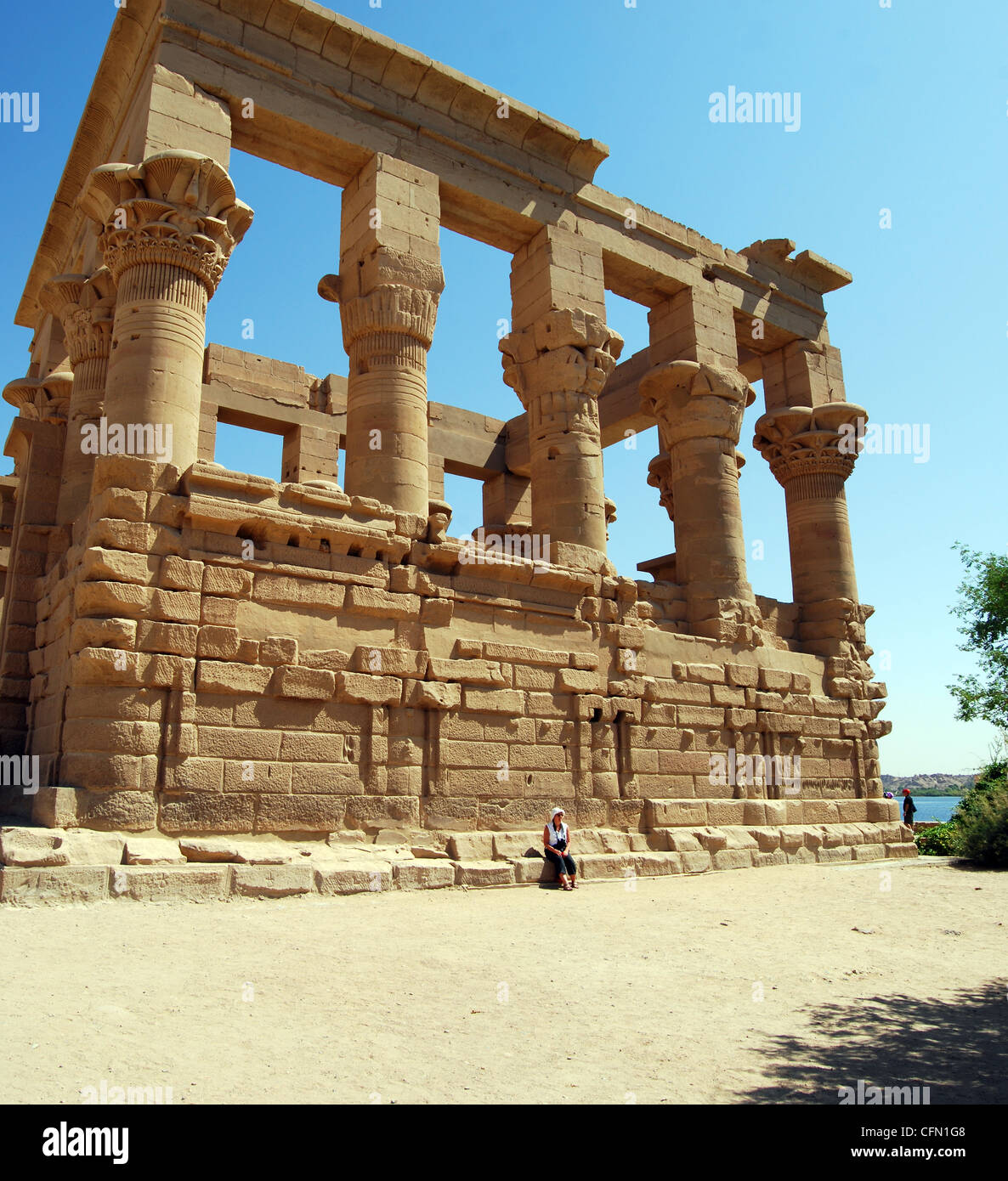 Philae Temple with person to show scale number 3065 Stock Photohttps://www.alamy.com/image-license-details/?v=1https://www.alamy.com/stock-photo-philae-temple-with-person-to-show-scale-number-3065-44102808.html
Philae Temple with person to show scale number 3065 Stock Photohttps://www.alamy.com/image-license-details/?v=1https://www.alamy.com/stock-photo-philae-temple-with-person-to-show-scale-number-3065-44102808.htmlRMCFN1G8–Philae Temple with person to show scale number 3065
 Coffin of Wenuhotep. Egyptian. Date: 780 BC. Dimensions: 44.1 × 181 × 51.4 cm (17 3/8 × 71 1/4 × 20 1/4 in.). Wood, pigment. Origin: Egypt. Museum: The Chicago Art Institute. Author: Ancient Egyptian. Stock Photohttps://www.alamy.com/image-license-details/?v=1https://www.alamy.com/coffin-of-wenuhotep-egyptian-date-780-bc-dimensions-441-181-514-cm-17-38-71-14-20-14-in-wood-pigment-origin-egypt-museum-the-chicago-art-institute-author-ancient-egyptian-image239835270.html
Coffin of Wenuhotep. Egyptian. Date: 780 BC. Dimensions: 44.1 × 181 × 51.4 cm (17 3/8 × 71 1/4 × 20 1/4 in.). Wood, pigment. Origin: Egypt. Museum: The Chicago Art Institute. Author: Ancient Egyptian. Stock Photohttps://www.alamy.com/image-license-details/?v=1https://www.alamy.com/coffin-of-wenuhotep-egyptian-date-780-bc-dimensions-441-181-514-cm-17-38-71-14-20-14-in-wood-pigment-origin-egypt-museum-the-chicago-art-institute-author-ancient-egyptian-image239835270.htmlRMRX5C9A–Coffin of Wenuhotep. Egyptian. Date: 780 BC. Dimensions: 44.1 × 181 × 51.4 cm (17 3/8 × 71 1/4 × 20 1/4 in.). Wood, pigment. Origin: Egypt. Museum: The Chicago Art Institute. Author: Ancient Egyptian.
 Panorama of the front of Philae temple number 3064 Stock Photohttps://www.alamy.com/image-license-details/?v=1https://www.alamy.com/stock-photo-panorama-of-the-front-of-philae-temple-number-3064-44102852.html
Panorama of the front of Philae temple number 3064 Stock Photohttps://www.alamy.com/image-license-details/?v=1https://www.alamy.com/stock-photo-panorama-of-the-front-of-philae-temple-number-3064-44102852.htmlRMCFN1HT–Panorama of the front of Philae temple number 3064
 Lotus Flower. Egyptian. Date: 1069 BC-664 BC. Dimensions: 7.3 × 8.9 × 5.1 cm (2 7/8 × 3 1/2 × 2 in.). Bronze, inlay (?). Origin: Egypt. Museum: The Chicago Art Institute. Author: Ancient Egyptian. Stock Photohttps://www.alamy.com/image-license-details/?v=1https://www.alamy.com/lotus-flower-egyptian-date-1069-bc-664-bc-dimensions-73-89-51-cm-2-78-3-12-2-in-bronze-inlay-origin-egypt-museum-the-chicago-art-institute-author-ancient-egyptian-image239865689.html
Lotus Flower. Egyptian. Date: 1069 BC-664 BC. Dimensions: 7.3 × 8.9 × 5.1 cm (2 7/8 × 3 1/2 × 2 in.). Bronze, inlay (?). Origin: Egypt. Museum: The Chicago Art Institute. Author: Ancient Egyptian. Stock Photohttps://www.alamy.com/image-license-details/?v=1https://www.alamy.com/lotus-flower-egyptian-date-1069-bc-664-bc-dimensions-73-89-51-cm-2-78-3-12-2-in-bronze-inlay-origin-egypt-museum-the-chicago-art-institute-author-ancient-egyptian-image239865689.htmlRMRX6R3N–Lotus Flower. Egyptian. Date: 1069 BC-664 BC. Dimensions: 7.3 × 8.9 × 5.1 cm (2 7/8 × 3 1/2 × 2 in.). Bronze, inlay (?). Origin: Egypt. Museum: The Chicago Art Institute. Author: Ancient Egyptian.
 capital at Philae temple number 3066 Stock Photohttps://www.alamy.com/image-license-details/?v=1https://www.alamy.com/stock-photo-capital-at-philae-temple-number-3066-44102651.html
capital at Philae temple number 3066 Stock Photohttps://www.alamy.com/image-license-details/?v=1https://www.alamy.com/stock-photo-capital-at-philae-temple-number-3066-44102651.htmlRMCFN1AK–capital at Philae temple number 3066
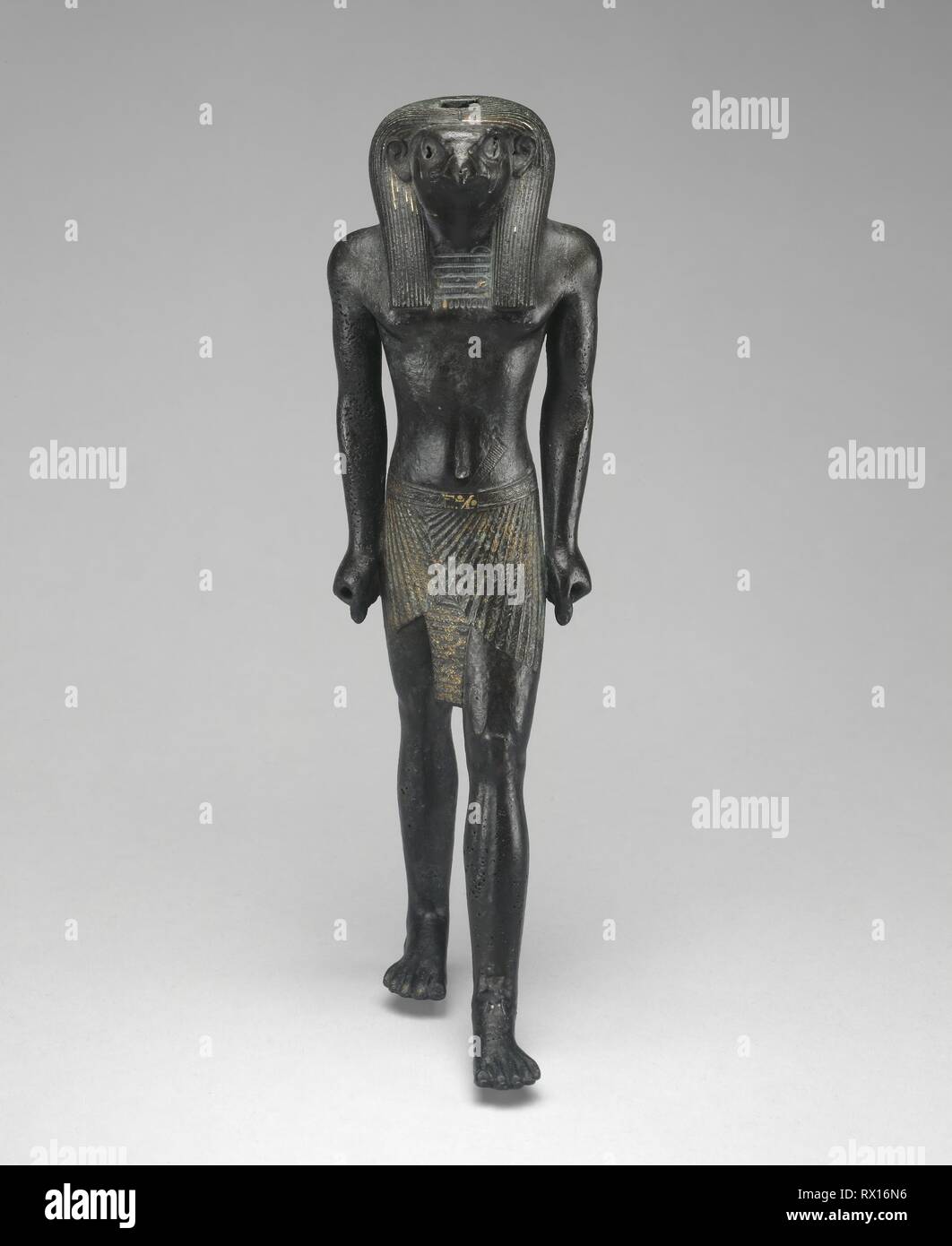 Statuette of Re-Horakhty. Egyptian. Date: 1069 BC-664 BC. Dimensions: 25 × 8.3 × 10.5 cm (9 7/8 × 3 1/4 × 4 1/8 in.). Copper alloy with gilding. Origin: Egypt. Museum: The Chicago Art Institute. Author: Ancient Egyptian. Stock Photohttps://www.alamy.com/image-license-details/?v=1https://www.alamy.com/statuette-of-re-horakhty-egyptian-date-1069-bc-664-bc-dimensions-25-83-105-cm-9-78-3-14-4-18-in-copper-alloy-with-gilding-origin-egypt-museum-the-chicago-art-institute-author-ancient-egyptian-image239743090.html
Statuette of Re-Horakhty. Egyptian. Date: 1069 BC-664 BC. Dimensions: 25 × 8.3 × 10.5 cm (9 7/8 × 3 1/4 × 4 1/8 in.). Copper alloy with gilding. Origin: Egypt. Museum: The Chicago Art Institute. Author: Ancient Egyptian. Stock Photohttps://www.alamy.com/image-license-details/?v=1https://www.alamy.com/statuette-of-re-horakhty-egyptian-date-1069-bc-664-bc-dimensions-25-83-105-cm-9-78-3-14-4-18-in-copper-alloy-with-gilding-origin-egypt-museum-the-chicago-art-institute-author-ancient-egyptian-image239743090.htmlRMRX16N6–Statuette of Re-Horakhty. Egyptian. Date: 1069 BC-664 BC. Dimensions: 25 × 8.3 × 10.5 cm (9 7/8 × 3 1/4 × 4 1/8 in.). Copper alloy with gilding. Origin: Egypt. Museum: The Chicago Art Institute. Author: Ancient Egyptian.